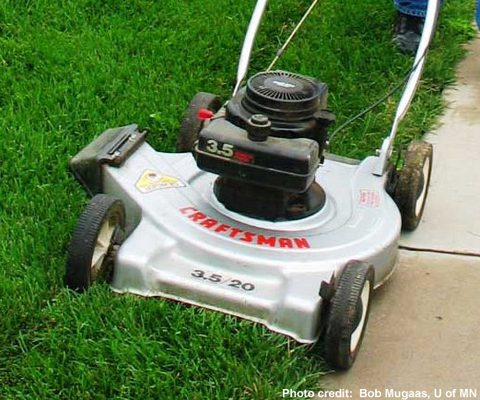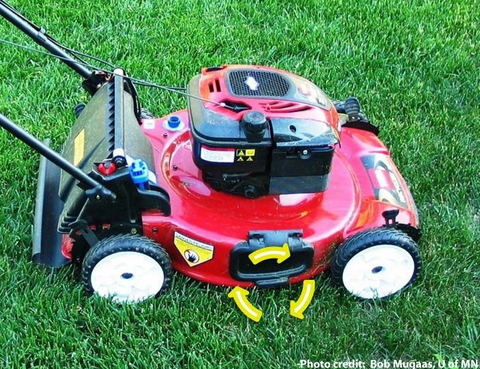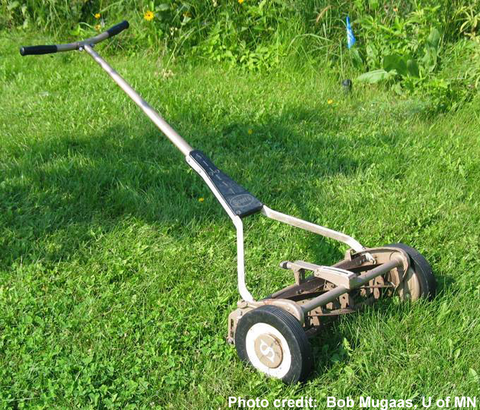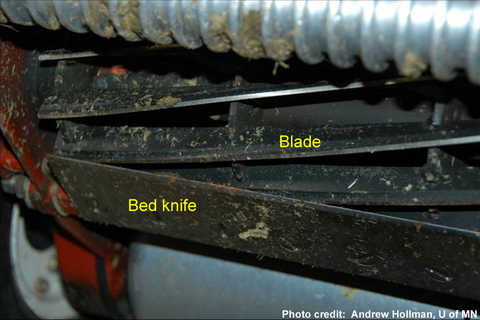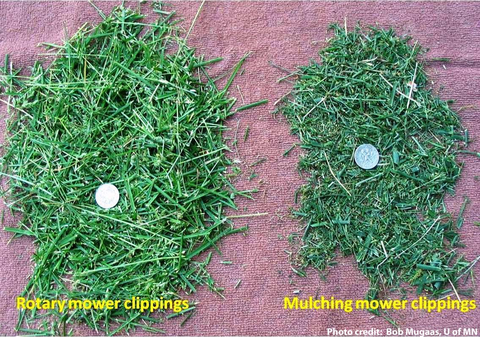Choosing a mower
The two principal types of mowers available for use on home lawns include "reel" and "rotary" lawn mowers. Regardless which type is chosen, it is very important to keep the lawn mower blades as sharp as possible. Dull lawn mower blades tear grass blades rather than cutting them. This results in injured plants.
Rotary lawn mowers
Rotary lawn mowers have a whirling horizontal blade. Rotating blades have the potential for throwing stones or other small objects in the path of the mower. Therefore, rotary lawn mowers can be more dangerous to operate than reel lawn mowers.
Rotary lawn mowers cut the grass by impact, similar to the way a machete works. This causes a rougher, more uneven cut than reel lawn mowers. However, rotary lawn mowers do an acceptable job on virtually any lawn. In addition, they are easier to maintain then reel lawn mowers and can cut taller grass.
Mulching lawn mowers
Mulching or recycling lawn mowers are now available. A mulching lawn mower recuts grass clippings into smaller pieces and redistributes them uniformly back into the lawn for rapid decay. When the turf is wet, clumping is common with mulching lawn mowers because of the excess water present.
Push-type reel lawn mowers
There is a growing movement among people with small, easily managed yards, back to "old-fashioned" push-type reel lawn mowers. Newer versions are smaller, lighter-weight, and easier to push than the old clunkers you may have used as a youngster. They have the advantage of quiet, fuel-free operation, and can provide good exercise at the same time.
Reel lawn mowers
Reel lawn mowers have a series of revolving blades that cut against a stationary bedknife, much like a scissors. While reel lawn mowers provide the finest quality of cut available, they are expensive, not easily adjusted, and require specialized equipment for sharpening. Also, they can't be used where stones, twigs, or other debris are a problem because of potential damage to the cutting units. They are also not well adapted for use in higher heights of cut.
Mower maintenance
Keep all mowing equipment in good working condition. Consult lawn mower manual for annual routine maintenance practices.
As a general rule, sharpen and adjust lawn mower blades frequently to assure a clean cut. A dull rotary lawn mower blade frays the ends of grass blades and results in brown tips, which are unsightly and increase the plants' susceptibility to certain plant diseases.
Mowing safety
Modern lawn mowers are equipped with certain safety devices which should not be removed or tampered with. One safety feature is a blade that stops turning when the operator's hands are removed from the controls. Another is a rear-mounted rope pull for starting the mower. This reduces the chance of getting one's foot caught in the blades during starting.
Many rotary lawn mowers have bagging attachments which affect mower safety. The manufacturer may have a special attachment which is required for safe mowing without a bag. Similarly, discharge chute shields on non-bagging lawn mowers should not be removed.
Steep slopes are both difficult and dangerous to mow. These slopes are good candidates for alternative groundcovers or a no-mow grassed slope that will stabilize the bank and eliminate the need for routine maintenance such as mowing.
Additional mowing safety practices
- Pick up rocks, wires, and sticks before mowing to prevent them from becoming dangerous projectiles.
- Keep all spectators away from the lawn mower while it is in operation.
- Children should not be allowed to operate lawn mowers until they can handle them safely and easily.
- Always consult the owner’s manual for precautions and instructions on using lawn mowers safely.
- Use earplugs when operating noisy power lawn mowers.
- Wear sturdy shoes that protect the feet.
- Always push the lawn mower forward. Never pull it backward in a motion where a slip will allow your foot under the mower deck.
- Mow across a slope, not up and down as good footing is important in steep slopes.
- Delay mowing when grass is wet. Dry grass is less apt to plug lawn mowers and footing is better on dry grass.
Reviewed in 2018


